|
Away
We Go Awassailing
by
Bob Brooke
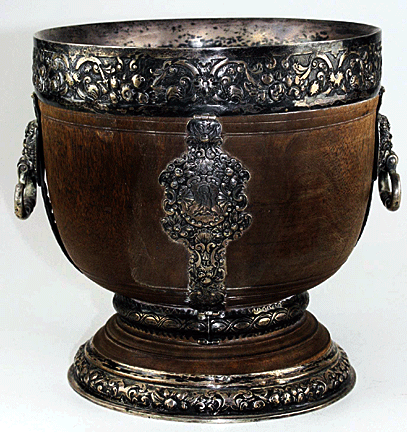
Wassail, wassail all over the town
Our bread it is white, and our ale it is brown
Our bowl It is made of the maple tree
So here, my good fellow, I'll drink to thee.
Wassailing is a
very ancient custom that’s rarely done today. The custom predates the
Battle of Hastings in England. However, historians believe its origins
date to Ancient Rome, where people would make sacrifices to the Pomona,
the Roman Goddess of Fruits. The word wassail originates from the
Anglo-Saxon waes-hael, meaning “to your health.”

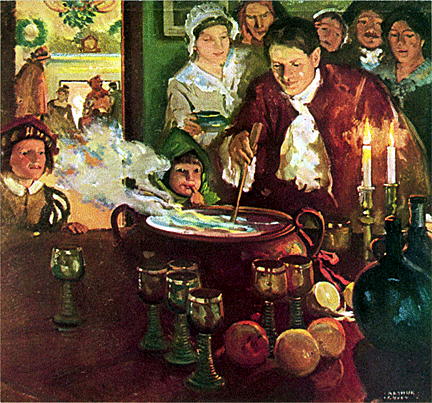 Originally,
the wassail was a drink, made of mulled ale, curdled cream, roasted
apples, eggs, cloves, ginger, nutmeg and sugar, served from huge cups or
bowls. Wassailing was traditionally done on New Year's Eve and Twelfth
Night, but some rich people drank wassail on all the 12 days of
Christmas. The wassail drink mixture was sometimes called 'Lamb's Wool,”
because of the pulp of the roasted apples looked all frothy and a bit
like lambs wool. Originally,
the wassail was a drink, made of mulled ale, curdled cream, roasted
apples, eggs, cloves, ginger, nutmeg and sugar, served from huge cups or
bowls. Wassailing was traditionally done on New Year's Eve and Twelfth
Night, but some rich people drank wassail on all the 12 days of
Christmas. The wassail drink mixture was sometimes called 'Lamb's Wool,”
because of the pulp of the roasted apples looked all frothy and a bit
like lambs wool.
One legend about the creation of wassailing says
that a beautiful Saxon maiden named Rowena presented Prince Vortigen
with a bowl of wine while toasting him with the words “waes hael.” Over
the centuries, a great deal of ceremony developed around the custom of
drinking wassail. Merrymakers carried the wassail bowl into a room with
great fanfare while singing a traditional carol about the drink, and
finally, they served the steaming hot beverage.
The
Wassail Bowl
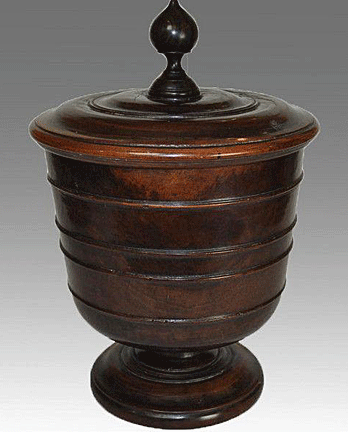 The
wassail bowl, itself, was a monstrous thing. No ordinary cup would do
for such a grand ritual. The oldest and grandest were those turned from
a hard wood, but wassail bowls could also be made of pottery, silver,
tin, or pewter. Jesus College, in Oxford University, has a wassail bowl
sheathed in sterling silver that can hold 10 gallons of drink. These
bowls often had many handles for shared drinking, as well as highly
decorated lids. The
wassail bowl, itself, was a monstrous thing. No ordinary cup would do
for such a grand ritual. The oldest and grandest were those turned from
a hard wood, but wassail bowls could also be made of pottery, silver,
tin, or pewter. Jesus College, in Oxford University, has a wassail bowl
sheathed in sterling silver that can hold 10 gallons of drink. These
bowls often had many handles for shared drinking, as well as highly
decorated lids.
Oliver Cromwell prohibited Christmas and its associated celebrations
under his Puritanic rule, but the 1660 Restoration marked a resurgence
of festive celebrations. As a result, many wassail bowls and cups that
survive today date from the last four decades of the 17th century, when
“old world” customs and trappings came back into fashion.
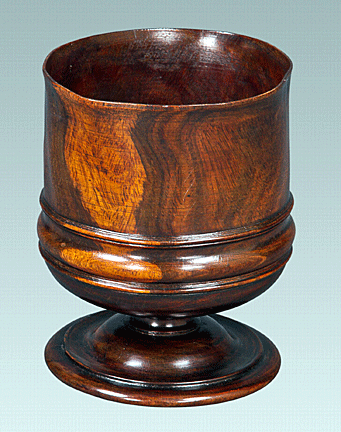 The
first wassail bowls and cups made from Lignum Vitae appear to have been
produced in Britain in the second quarter of the 17th century. The use
of this material seems closely related to the expansion of Britain’s
colonial power and trade during that century. The
first wassail bowls and cups made from Lignum Vitae appear to have been
produced in Britain in the second quarter of the 17th century. The use
of this material seems closely related to the expansion of Britain’s
colonial power and trade during that century.
Lignum Vitae is the hardest and heaviest of commercial woods.
Traditionally used in shipbuilding and making police truncheons and
bowling balls, it was especially suited for making vessels to hold hot
liquids because of its toughness.
Traditionally, Ligum Vitae also boasted medicinal properties, and
European merchants imported it from the 16th century onwards as a remedy
for a variety of ailments, from gout to syphilis. Although some
surviving wassail bowls are ceramic or made from maple wood, the idea of
drinking from a bowl or cup made from a material that promised good
health for the year ahead would have been especially appealing during
the centuries when life expectancy was lower than today, and health care
for all but the wealthy was reliant on traditional remedies.
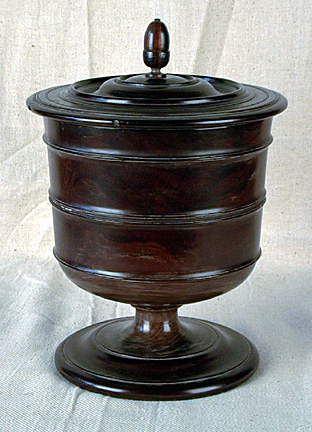 The
wassailing bowl, toast within The
wassailing bowl, toast within
Come, fill it up unto the brim
Come fill it up that we may all see
The wassailing bowl I’ll drink to thee.
Come, butler, come bring as a bowl of your best
And we hope your soul in heaven shall rest.
But if you do bring us a howl of your small
Then down shall go butler and bowl and all.
The
Wassail
The earliest versions of wassail consisted of warmed mead into which
people dropped roasted crab apples which burst to create a drink called
“lambs wool”' drunk on Lammas Day, still known in Shakespeare's time.
Later, the drink evolved into a mulled cider made with sugar, cinnamon,
ginger and nutmeg, topped with slices of toast as sops, drunk from a
large communal bowl. People often added apples or oranges to the mix.
Some recipes also called for beaten eggs to be tempered into the drink.
A
Recipe for Wassail
4 to 6 apples
3 liters of good cider
6 cinnamon sticks
dark rum, to taste
soft dark brown sugar, to taste
around 500ml of water
toast (optional)
Prepare the apples; cut around them a circle halfway down, this
stops them bursting when cooking, place on a tray and bake in a
moderate oven until they have begun to collapse, around 30
minutes. Whilst you wait for the oven to do its job, pour the
cider into a large pan with the cinnamon stick, at least 3
generous tablespoons of sugar and 250ml of rum and half of the
water. Bring to a simmer and add more sugar and rum, and dilute
accordingly with more water. Lastly, for tradition’s sake, atop
with slices of toast. |
The Toast
The English word wassail` comes from the Middle
English phrase "wes heil,” which means "be whole" or "be healthy." The
contemporary English word "hale," meaning sound, health or vigorous.
evolved from the second word in this phrase. Medieval Britons toasted
each other with the cry, "Wes heil!" the proper open response was "Drine
heil!" meaning "drink wholeness" or "drink health" The phrase first
appears in a 12th-century document.
During the 12th century, when King Venn VI called for his wassail howl
on Twelfth Night, he and his court observed the following ritual. The
chapel choir came into the hall and stood to one side. Next, the steward
entered the hall with the royal bowl and cried "Wassail" three times.
Then the choir burst into song.
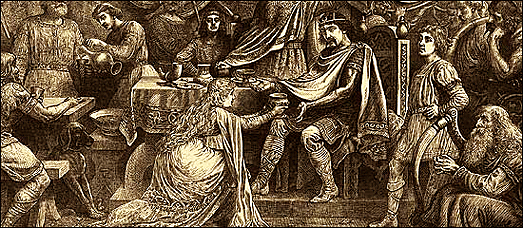
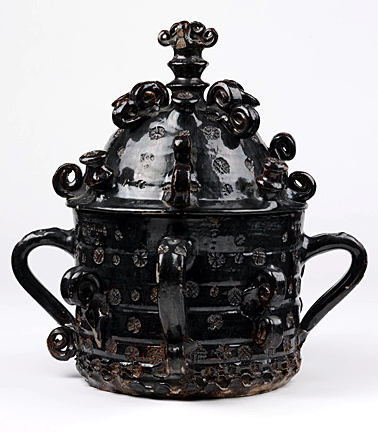 A
14th-century document reveals that in that era the toast “wes heil"
accompanied the passing of a communal cup. Each person in the gathering
received the cup along with a kiss, sipped from the vessel, toasted the
next person, and passed the cup to them. A document dating from the 13th
century mentions a special wassail bowl designed for communal dunking of
bread and cakes. By the end of the 14th century, many wealthy English
families possessed heirloom wassail bowls. Much ceremony often
accompanied the use of these bowls. A
14th-century document reveals that in that era the toast “wes heil"
accompanied the passing of a communal cup. Each person in the gathering
received the cup along with a kiss, sipped from the vessel, toasted the
next person, and passed the cup to them. A document dating from the 13th
century mentions a special wassail bowl designed for communal dunking of
bread and cakes. By the end of the 14th century, many wealthy English
families possessed heirloom wassail bowls. Much ceremony often
accompanied the use of these bowls.
The
Caroling Custom
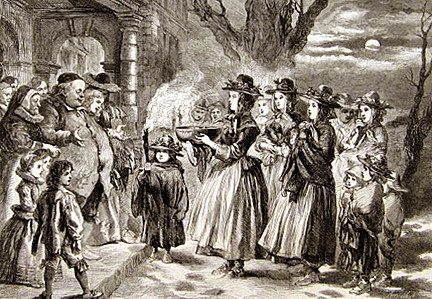 Historical
evidence suggests that sometime in the 16th century common folk began
carrying wassail bowls from house to house during the Christmas season.
They gamished the bowl with decorations such as ribbons, holly,
mistletoe or other greenery, and colored paper. Crying, "Wassail,
wassail," they brought the decorated bowl full of spiced ale to their
wealthy neighbors, hoping to exchange a cup of Christmas ale for a gift
of food or a tip. Hence, the groups became known as “wassailers;” and
the custom itself, "wassailing." In another variant of this custom, the
wassailers carried an empty bowl to their neighbors, bidding the
householders fill it up for them. Historical
evidence suggests that sometime in the 16th century common folk began
carrying wassail bowls from house to house during the Christmas season.
They gamished the bowl with decorations such as ribbons, holly,
mistletoe or other greenery, and colored paper. Crying, "Wassail,
wassail," they brought the decorated bowl full of spiced ale to their
wealthy neighbors, hoping to exchange a cup of Christmas ale for a gift
of food or a tip. Hence, the groups became known as “wassailers;” and
the custom itself, "wassailing." In another variant of this custom, the
wassailers carried an empty bowl to their neighbors, bidding the
householders fill it up for them.
<
Back to Antiques Archives
Next Article > |
